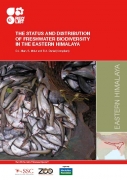 One of the main reasons cited for inadequate representation of biodiversity is a lack of readily available information on the status and distribution of inland water taxa.
One of the main reasons cited for inadequate representation of biodiversity is a lack of readily available information on the status and distribution of inland water taxa.
In response to this need for information, the IUCN Species Programme, in collaboration with Zoo Outreach Organisation (ZOO) conducted the Eastern Himalaya Freshwater Biodiversity Assessment, a review of the global conservation status of 1,073 freshwater species belonging to three taxonomic groups – fishes (520 taxa), molluscs (186 taxa), and odonata (dragonflies and damselflies) (367 taxa).
Other groups that include freshwater species that have been comprehensively assessed are freshwater crabs (assessed in 2008, and 57 species of crab are present within the assessment region), mammals, birds, and amphibians and their assessments can be accessed on the IUCN Red List.
The geographic scope of this study is determined by the extended hydrological boundaries of the Eastern Himalaya region and includes all major river catchments with their origin within the Eastern Himalaya Biodiversity Hotspot. In the process of study, which is based on the collation and analysis of existing information, experts were trained in biodiversity assessment methods, including the application of the IUCN Red List Categories and Criteria and species mapping using GIS software. Distribution ranges have been mapped for the majority of species providing an important tool for application to the conservation and development planning processes.
The key results of the study and recommendations are indicated below –
- 7.2% of species of the 1,073 freshwater taxa assessed are threatened with extinction, with a further 5.4% assessed as near threatened. No taxa were assessed as extinct or extinct in the wild.
- Many species were assessed as data deficient (31.3%), emphasizing the need for extensive new research into species taxonomy, distributions, population trends, and threats.
- These high concentrations of threatened species are all found within the boundaries of the Eastern Himalaya Biodiversity Hotspot. Habitat loss and degradation, mainly due to sedimentation, pollution (from urban, agricultural, and industrial sources), forest clearance, and the development of dams are the major causes of species decline.
- A major priority for the region is to reduce the currently high number of species assessed as data deficient due to insufficient information on their current status and distributions. This requires new initiatives to conduct field surveys in the least known areas, as well as investments in taxonomic study and the training of young taxonomists.
- The current lack of information on so many species represents a significant bottleneck in progress towards the effective management and conservation of the regions wetland biodiversity. The priority areas identified as candidate freshwater Key Biodiversity Areas (KBAs) can help focus development and conservation actions in ways that aim to minimize impacts to freshwater species throughout the region.
- Communities with a stake in the long-term future of freshwater species and habitats across the region must be fully engaged in the development and conservation planning processes in order to assure the future sustainability of associated livelihoods and the ecosystem services provided by fully functioning wetland ecosystems.
All assessments and species distribution maps are available on the IUCN Red List (www.iucnredlist.org).